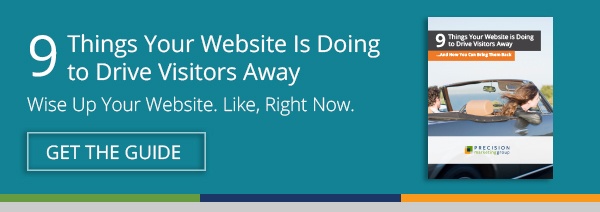What is arguably THE most important and revealing metric to monitor and improve on your website?
Traffic? Nope. If you get the "most" important metric working, it will help you get more traffic.
Conversions? As important as it is, something is even more important. The more important metric, if done right, will lead to more conversions.
What is this crucial metric you need to be monitoring and improving?
Website visitor engagement.
Website Visitor Engagement—a Revealing Metric
The level of visitor engagement on a company's website is an often overlooked dynamic that can tell you soooo much about how well (or how poorly) you are doing when it comes to connecting with your prospects.
When a website visitor is engaged, they stay on your website for a longer period of time and typically go to more pages.
They are grooving with you and what you offer because:
- You're touching on topics of interest to them.
- You're scratching them where they itch and giving them hope for a solution to their problem.
- You're speaking their language. They can't help but conclude "you understand my situation… and can help!"
Conversely, when someone comes to your website but then quickly decides to leave, what does that tell you?
- You're not giving them what they hoped to find at your website.
- You're not able to connect with them.
- OR your website is turning them away because it is too hard to navigate, confusing, or too hard to read—too this or not enough that.
It's going to be hard to turn these folks into leads and customers.
Website engagement levels help clue you in on whether or not you are on the right track with your messaging and even the layout of your website.
But, there is a surprising additional benefit when you get it right...
Engagement Leads to More Traffic
Higher website visitor engagement is so valuable because it can also lead to MORE traffic.
How? Over time you become the recipient of what I like to call Google Love.
Google Love is what Google bestows upon websites it deems relevant to searchers. Remember one of the core values of Google is helping the searcher find what they are looking for (a relevant website) as quickly as possible.
Part of that equation is what the searcher does once they land on your website.
For example, if a searcher comes to your website after searching for "email platforms for media companies" (which, for this example, is one of your products) and they spend a good amount of time on your website (presumably consuming content) and visiting numerous pages, Google concludes the searcher found what they were looking for.
The next time someone searches for "email platforms for media companies" Google sends more of that traffic to you. If, over time, you are able to engage the right people with the right content, Google notices and keeps sending you more and more of this valuable targeted traffic… for free.
Google Love is a wonderful thing.
Increasing Website Visitor Engagement
You might be thinking, "Okay, I get it. Website visitor engagement is really important. What can I do to improve mine?"
Here are three proven ways to boost your website visitor engagement:
1. Narrow your focus.
Since you can't (and shouldn't) be all things to all people, you must choose 3-5 visitor types (or buyer personas) who you are trying to attract. You then create content that's important to them and addresses what they want and need to hear.
The more specific you can be (as if you've been in their head and you feel what they feel), the more you will engage these MVPs: Most Valuable Prospects.
The biggest objection to this approach is thinking that you must cast a wide net to catch as many fish as possible.
However, the reality is the opposite. The wide net actually has wide gaps in the netting, which leads to fewer fish.
If you try to be all things to all people, you will ultimately be meaningful and engaging to a very small percentage, if any.
2. Change your focus.
So much website content out there is written from the perspective of the company.
- Who we are
- Why our products and services are what you need
- Why you can trust us
Instead, your content (initially) needs to be focused on your prospects: their needs, their pain points and desires, using language they can relate to.
Once they sense you understand them, their needs and what's important to them, THEN you can introduce yourself.
Think of it like this: Which sales person would YOU more easily engage with (and ultimately buy from)?
- Sales person #1 – who talks first and always about themselves and their products (and doesn’t seem to be interested in your unique situation).
- Sales person #2 – who shows interest in you and your needs/situation, asks questions, who restates what you say so you know you are being heard… and only then offers a solution that fits what you need.
Your website should work the same way.
3. Reduce friction points on your website.
In a nutshell, friction points are anything that make interacting with your website harder for the visitor. Examples might include:
- The layout is confusing.
- Your navigation isn't helpful for finding exactly what visitors are looking for.
- There are elements that make it harder to process the information—the font size is too small, the colors are too faint, there are too many words without white space relief, etc.
- There is no clear path for a visitor to follow. Instead, various elements on the page are all shouting in unison "Read me! Notice me!"
People will choose easy over difficult every day of the week. If your website is too difficult for a prospect to find what they are looking for, they will go somewhere else.
Even if they fight their way through and stay on your website, research has shown that they become a harder prospect to reach. The extra work forces them to rely more heavily on the part of the brain that is highly cautious and skeptical about truth claims.
In other words, increased friction causes a person to be more on guard and less easy to persuade with respect to the value of your offering.
Have you ever tried to persuade someone who is guarded and skeptical? It's a tough road to take. Do all you can to reduce website friction so you can avoid putting visitors into that state of mind.
Tools for Determining User Engagement
There are several tools you can use to accurately assess your website visitor engagement—some of which are free. We consistently work with the first three listed below, but there have been a lot of recent developments in this space (some involving Artificial Intelligence), and there may be other platforms that better suit your needs.
Website Visitor Engagement: Your Gateway to More Traffic and Sales
Website visitor engagement is like the x-ray machine that reveals the broken bones in your online efforts to grow your business.
When you shore up those areas, using the tools above, you will be utterly amazed as to how well your website will work, in an automated way 24/7 at gathering more leads and new business.
YOUR TURN! Is website visitor engagement something your company has worked on in the past? If so, what's the one thing that has helped the most?




